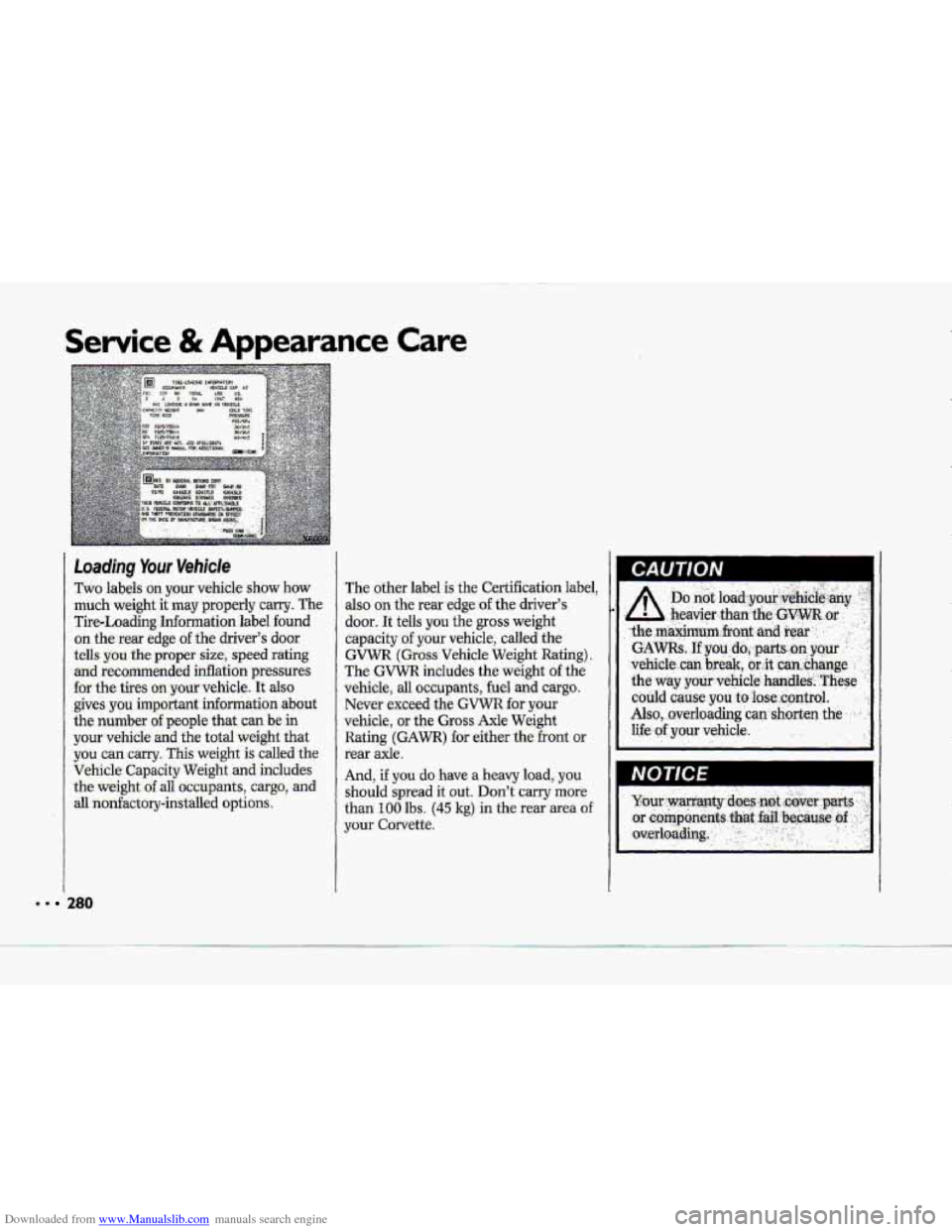Page 237 of 370
Downloaded from www.Manualslib.com manuals search engine Problems on the Road
Compact Spare Tire
Although the compact spare was fully
inflated when your vehicle was new, it
can lase air after a time. Check the
inflation pressure regularly. It should be
60 psi (420 1tPa). The compact spare is
made to go up to 3,000 miles (5 OOO km),
so you can finish your trip and have
your
full-size tire repaired or replaced
where. you want. Of course, it's best to
replace your .s.parewith .a full-size tire as
soon as you can. Your -spare will last
longer and
be in good shape in case you
need
it again.
!36
'OTIC E
Don't use your compact. spare on some
other vehicle.
And don't mix your compact spare or
wheel with other wheels or tires. They
won't fit. Keep your spare and its -wheel
together.
Page 281 of 370

Downloaded from www.Manualslib.com manuals search engine Service & Appearance Care
I
= * 280
Two labels on your vehicle show how
much weight
it may properly carry. The
Tire-Loading Information label found
on
the rear edge of the driver's door
tells
you the proper size, speed rating
and recommended inflation pressures
€or the tires
on your vehicle. It also
gives you impartant information about
the number
of people that can be in
your vehicle and the total weight that
you can carry. This weight is called the
Vehicle Capacity Weight and includes
the weight of all occupants, cargo, and
all nonfactory-installed options. The other
label is the Certification label,
also on the rear
edge of the driver's
door. It
tells you the gross weight
capacity of
your vehicle, called the
GVWR (Gross Vehicle Weight Rating).
The
GVWR includes the weight of the
vehicle, all occupants, fuel and cargo.
Never exceed the GVWR
for your
vehicle, or the Gross Axle Weight
Rating
(GAWR) for either the front or
rear axle.
And, if you do have a heavy load, you
should spread it out. Don't carry more
than
100 lbs. (45 kg) in the rear area of
your Corvette.
I I
U
i
Page 283 of 370
Downloaded from www.Manualslib.com manuals search engine Senrice & Appearance Care
CAUTION
Inflation-Tire Pressure
The Tire-Loading Information label
! which is on the rear edge of the driver’s
door
shows the correct inflation
pressures for your tires, when they’re
cold. “Cold” means your vehicle has
been sitting for at least three hours or
driven no more than a mile.
If you have to check tires when they’re
not cold,
add 4 psi (28 kPa) to the
numbers on the sticker.
. 282
Page 334 of 370

Downloaded from www.Manualslib.com manuals search engine a
w
c
Section B: Owner Checks & Servrces
Listed below are owner checks and s&vice:s which should be
performed at the intervals specified to help ensure th-e
safety, dependability and emission control performance of
your vehicle.
Be sure any r~ecessary repairs .are completdat once,
Whenever any fluids or lubricants-are added to your vehicle,
make
sure they are the proper ones, -as shown in Section D.
CHECK
OR SERVICE _. -
Engine Oil Level
Engine
Coolant Level
Windshield WashGl
Fluid .Level
WHAT .TO. DO *
Check the engine oil level and add the proper oil if necess-ary. If you have a ZR-1 you-should
check your engine oil when the engine is cold. See the Indecx under Engine OiG for Mer details.
Check the engine. coolant level in the coolant recovery tank and add the proper coalant mix if
necessary. See the Index under Coolant for further details.
Check the windshield washer flui.d level in the windshield washer’ tank and add the proper fluid
if necessary. See the Ida under W7ndshieZd Wusher.nuid for further details.
At Least Once a Month
CHECK WHAT TO DO 0R.SERVICE
Tire Inflation Check tire inflation. Make sure they are inflated to the pressures specified on the Tire-Loading
Information label. located on the rear edge of the driver’s door. See the Index under Eres for
further details.
333 . .